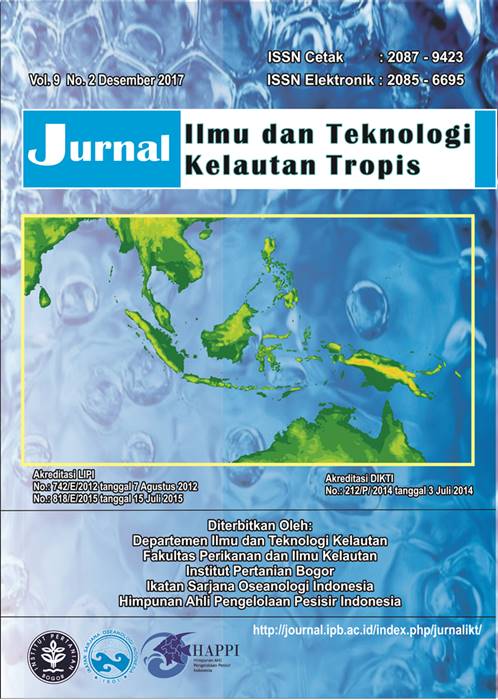CHARACTERIZATION OF NANOHYDROXYAPATITE FROM TUNA’S Thunnus sp BONE AS BIOMATERIALS SUBSTANCE
Abstract
Tuna Thunnus sp is a high-value fisheries products. The abundance of waste from tuna’s processing industry has not been used optimally. The objective of this study was to produce and characterize nanohidroxyapatite (Ca5(PO4)3((OH)0.8F0.2) of tuna’s Thunnus sp bone waste using high temperature sintering of 400-800OC continuing by nanomilling method. The results of the characterization showed that the sintering temperature of 800OC was the best treatment yielding of hidroxyapatite 57.73%, 89.27% white degree level. The result of statistic analysis showed that the sintering temperature variation gave a significant effect on the white degree at the test level (p <0.05). Proximate result after sintering showed moisture content of 0.15%, 99.83% ash, 0.05% fat, 0.73% protein and 0% crude fiber. Results of heavy metal analysis showed the content of lead (Pb) and mercury (Hg) was negative, and cadmium (Cd) 0.018 ppm. The mineral test consist of calcium, phosphor, kalium, magnesium, iron, zinc, manganese, and sodium with the dominant elements were 49.76% calcium and 9.02% phosphor. The result of statistic analysis showed that the sintering temperature variation gave significant effect to the three main minerals at the test level (p<0.05). The Particle Size Analyzer test showed that nanohidroxyapatite particles was measured at 800-900 nm. The X-Ray Diffractometer analysis showed the results of sample identification contains hydroxyapatite and fluorian, with syn 100.00%. The hidroxyapatite was a compound complex and crystals formed has a hexagonal shape with a percentage of 82.9% crystallinity.
Keywords : bone, nanohidroxyapatite, particles, sintering, tuna
Authors
This work is licensed under a Creative Commons Attribution 4.0 International License.
Jurnal Ilmu dan Teknologi Kelautan Tropis i is an open-access journal, meaning that all content is freely available without charge to the user or their institution. Users are allowed to read, download, copy, distribute, print, search, or link to the full texts of the articles in this journal without needing to request prior permission from the publisher or the author.
All articles published by Jurnal Ilmu dan Teknologi Kelautan Tropis are licensed under the Creative Commons Attribution 4.0 International License. This allows for unrestricted use, distribution, and reproduction in any medium, provided proper credit is given to the original authors.
Authors submitting manuscripts should understand and agree that the copyright of published manuscripts is retained by the authors. Copyright encompasses the exclusive rights of authors to reproduce, distribute, and sell any part of the journal articles in all forms and media. Reproduction of any part of this journal, its storage in databases, and its transmission by any form or media is allowed without written permission from Jurnal Ilmu dan Teknologi Kelautan Tropis.


